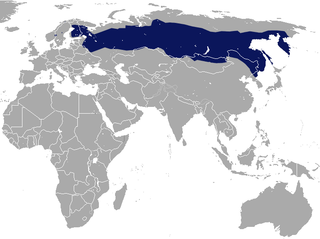
The smoky shrew is a medium-sized North American shrew found in eastern Canada and the northeastern United States and extends further south along the Appalachian Mountains.

The Eurasian pygmy shrew, often known simply as the pygmy shrew, is a widespread shrew of the northern Palearctic.

The Gansu shrew is a red-toothed shrew found only in a small part of Gansu province and other adjacent areas of China. With its very limited range, it is sensitive to habitat loss and is listed as a "vulnerable species" in the Chinese Red List, while the IUCN lists it as being "data deficient"

Kozlov's shrew is a red-toothed shrew found only at the Mekong River, Tibet, China. It is listed as a data deficient species.

The long-clawed shrew is a species of shrew. An adult long-clawed shrew has a weight of less than 20 grams (0.71 oz) and a body length of 54 millimetres (2.1 in) to 97 millimetres (3.8 in), with a tail of 40 millimetres (1.6 in) to 53 millimetres (2.1 in). It is distributed through the uplands of northeastern Asia, including northeastern North Korea.

The Siberian large-toothed shrew is a species of shrew. An adult Siberian large-toothed shrew has a weight of 4.6–6.0 g (0.16–0.21 oz) and a body length of 5.5–6.4 cm (2.2–2.5 in), with a tail of 2.4–3.8 cm (0.94–1.50 in). This species is found across Northeast Asia, from Mongolia through northeastern China to the Russian Far East and the Paektusan region of North Korea.

The slender shrew is a species of shrew. An adult slender shrew has a weight of 1.5–5.3 g (0.053–0.187 oz) and a body length of 4.7–6.0 cm (1.9–2.4 in), with a tail of 4–5 cm (1.6–2.0 in); this makes it one of the smaller shrews found in its range. It is distributed across northeastern North Korea, Hokkaidō, and the Russian Far East including the Kuril Islands.

The taiga shrew, also known as the even-toothed shrew can achieve a body length of about 67 millimeters, with a tail of about 43 millimeters. This shrew is very similar to the long-clawed shrew. This species inhabits forested mountain valleys, and is found across northern Eurasia. It ranges from the Baltic Sea area through the Lake Baikal region of Siberia into the Russian Far East and along the Baekdu-daegan mountains of the Korean Peninsula.

The Olympic shrew is a rare species of shrew that lives in only 13 spots in northwest Washington state and, a recent discovery, in Burns Bog, located in Delta, BC.

The Chinese highland shrew is a species of shrew in the family Soricidae. It is found in China.

The Azumi shrew is a species of mammal in the family Soricidae. It is endemic to Japan, where it is found in the mountainous regions of central Honshu Island. It is a close relative of the Eurasian least shrew. It is threatened by habitat loss.

The Saint Lawrence Island shrew is a species of mammal in the family Soricidae. It is found only on Alaska's St. Lawrence Island.

The Paramushir shrew is a species of mammal in the family Soricidae. It is endemic to Russia. Its natural habitat is temperate forests. It is likely named for Paramushir Island, home to several other species of shrew in the genus Sorex.

The Apennine shrew is a species of shrew in the family Soricidae. It is endemic to Italy.

The Caucasian shrew is a species of mammal in the family Soricidae. It is found in Armenia, Russia and Turkey.

The Shinto shrew is a species of shrew of the genus Sorex that lives only on the islands of Japan. It is a mole-like mammal with a pointed snout, very small ears, and a relatively long tail. Like most shrews, it is tiny, has poor eyesight, and a very good sense of hearing and smell which it uses to locate its prey, mainly insects.

The Inyo shrew is a species of shrew found in the western United States. It is light gray and white in color, with a narrow skull and small body size, very similar in appearance to the related dwarf shrew, but paler and not as large. It can be found in many different habitats, from rocky, mountainous regions to wetlands and riparian areas. Not much is known about its behavioral and reproductive habits. While barely studied, their population is believed to be stable and not under any threat.

The Valais shrew is a species of mammal in the family Soricidae.


















